Colenso Power Station
Colenso Power Station was the first thermal power station to be operated by the Electricity Supply Commission (ESCOM) although it was not originally an ESCOM undertaking. The power station, sub-stations and transmission system, which constituted the Colenso Undertaking, were constructed by the Railway Administration. The station was to supply power for the electrification of the Natal main line between Glencoe Junction and Pietermaritzburg, a route length of 274 km. Electrification of the line had been authorised by Parliament in 1922 and the official opening of the line took place in June 1926. It was the second biggest railway electrification scheme in the world, second only to the Chicago line. (South African Railways and Harbours Magazine, July 1926:972)
When Colenso Power Station was taken over by ESCOM in January 1927, the principal equipment installed consisted of five generators and eight chain grate boilers with a total capacity of 60 MW. In 1959 there were nine generators, nineteen boilers and three cooling towers, and the total installed capacity was 165 MW. The first six generators and their associated boiler house constituted what became known as Colenso No. 1 and the last three generators and the second boiler house, Colenso No. 2.
The traction load in the year 1927 represented over 96% of the total sales and the demand could fluctuate over a range of 20 MW within a few minutes. Two additional boilers were installed to provide relief due to the fluctuating load, but by 1935 the traction load continued to pose a problem, with fluctuations from 10 to 45 MW within a few minutes. At times the power station would be “swamped” with load leading to momentary interruptions in supply. These fluctuations “called for exceptional vigilance” on the part of the boiler house staff and another two boilers were installed. By the end of 1936 the electrified railway line extended 186 miles [299 km] south-east from Colenso to Durban and a year later 135 miles [217 km] northwards to Volksrust and 142 miles [229 km] towards Bethlehem. At that stage power was supplied from Colenso Power Station for the whole of the railway traction load in Natal. The first additional generator was ordered at the beginning of World War II (1939-1945), but during the war and for a number of years after, there were serious delays in the delivery of new plant. Due to growth in load at Congella Power Station at Durban, commissioned in 1928, and which experienced even greater difficulties and delays in obtaining additional plant during the war years, Congella was unable to supply traction load until the end of 1948. (ESCOM Annual Reports 1929:21, 1935:14, 1938:23, 1948:12)
The original five generators were decommissioned in 1973, and the sixth in 1980, leaving only Colenso 2 in service with a station installed capacity of 80 MW. Colenso, the longest serving station at that time, was finally taken out of service and decommissioned in September 1985. The total net electrical energy sent out by Colenso from take over by ESCOM at the beginning of 1927 until closure in 1985 was 21 043 GWh. The total quantity of coal burnt was 15,4 million metric tons. (Figures from 1924, when the station started operating, until ESCOM took over in 1927 are not available). Auxiliary consumption within the station amounted to approximately 5% to 7% of total (gross) generation, depending on the load factor. (ESCOM Annual Reports 1973:67, 1980:49; ESCOM Statistical Yearbook 1985:12&13; ESCOM Statistical Yearbook 1995:15)
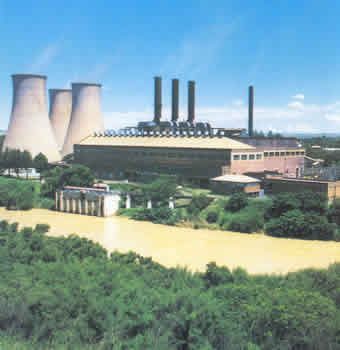
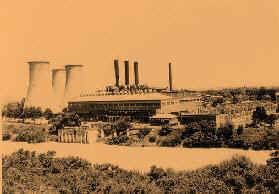
THE RAILWAYS AND ESCOM
By 1912 the Railways were considering the possible electrification of the Natal railway line and had already made cost estimates when World War I (1914-1918) broke out. Sir William Hoy, General Manager of the South African Railways and Harbours, realised that since there was no other power station available, the Railways would have to build their own. With this in mind, Messrs Merz and McLellan, Consulting Engineers from Great Britain and world leaders in the field of railway electrification, were appointed, in 1917, to report on railway electrification in South Africa. In the latter part of the year Mr F Lydall, an expert from Merz and McLellan arrived in South Africa to conduct investigations and collect data, and a report was submitted to Sir William Hoy dated June 1919. Charles Merz (later Dr) arrived personally in South Africa on 16 August 1919. FW Mills, Chief Electrical Engineer of the South African Railways and Harbours, conducted him over the various sections reported on. The report was laid before Parliament in September of that year. Acting on the advice of Sir William Hoy, the Government had requested Merz and McLellan, in January 1919, to study the general question of electric power supply in South Africa and Merz devoted a portion of his visit to this subject. He submitted his report to the Prime Minister, Jan Smuts, in April 1920. Merz envisaged power networks springing up as offshoots of railway electrification, and advocated the concentration of power production in a small number of large generating stations. In 1921 the Government appointed a Committee under the chairmanship of Sir Robert Kotze to consider the Merz report. The deliberations of this committee resulted in Parliament passing the Electricity Act of 1922, and the establishment of the Electricity Supply Commission (ESCOM) on 1 March 1923. (The name ESCOM was changed to Eskom in 1987). Dr Hendrik Johannes van der Bijl was appointed the first chairman. (Merz & McLellan 1920:(iii); Mills 1919:737/8; Sir William Hoy 1922:358-359; Sir Robert Kotze 1922:376-378; Lydall 1928:1021-2; ESCOM: Ten Years 1923-1933:7–8; ESCOM: Twenty-five Years 1923-1948:6&16; ESCOM: Golden Jubilee 1923-1973:10-11; Conradie & Messerschmidt 2000:47)
In their report of June 1919, Merz and McLellan reported on the possibilities and advantages of the electrification of (among others) the Cape Town-Simonstown suburban line and the Durban-Glencoe main line. The report pointed out the profitability of electrifying the Durban-Glencoe line, which was expected to give a return on net capital outlay of 40,3%. It suggested a power station be erected at Durban (four 8 MW sets) and another on the Buffalo River near Dundee, in the middle of the coal-fields (three 8 MW sets). A White Paper was laid before Parliament in June 1920, in which it was recommended that funds be voted immediately for the electrification of the Cape Town-Simonstown and Durban-Pietermaritzburg lines. Funds were provided, but the serious financial depression which intervened necessitated postponement of the Cape Town-Simonstown line (the Salt River Power Station would be built to supply power for this project). The original intention in Natal was to commence electrification of the line from the Durban end and work north to the coal-fields. However, rapid development in coal traffic in 1921 showed that work should be started from Glencoe Junction, near the coal-fields, instead of from Durban. (Merz & McLellan 1919:(v)-(vi), 25 & Table IX; Sir William Hoy, 1922:358-359; ESCOM Annual Report 1923:8-9)
The whole position was reviewed, together with the Consulting Engineers, in the light of the changed conditions. Mr Lydall carried out fresh investigations and a further White Paper was submitted to Parliament in February 1922. The Minister of Railways and Harbours (the Hon JW Jagger) stated in April 1922, that to delay improvement in the carrying capacity of the Natal line would be a “national misfortune” as the line was nearing the limit of its capacity with steam locomotives. It had become a question of doubling the line vs. electrification and it was decided to electrify the Glencoe-Pietermaritzburg section, which was mainly a single line of 171 route miles [274 km]. This decision, “during a period of acute financial stringency was a momentous one, but, on the reports submitted, was more than justified”. The 71 mile [114 km] Durban-Pietermaritzburg section was already a double line (the Clairwood-Mariannhill-Cato Ridge deviation with 10 tunnels had been opened in February 1921) and electrification of this line could be postponed. Merz and McLellan were appointed consulting engineers for the Natal electrification project, which included construction of the Colenso Power Station on the Tugela River to provide power, (and not Tayside on the Buffalo River, a few miles east of Glencoe, as originally suggested). Excavation work at Colenso was commenced in September 1922, before ESCOM was established, but it was anticipated that it would be taken over by ESCOM. The station started operating at the end of 1924 and was operated by the Railways until January 1927, when it was purchased and taken over by ESCOM. The scheme was the second biggest railway electrification scheme in the world, second only to the Chicago line. (Merz & McLellan 1919:22; South African Railways and Harbours Magazine, 1919:277, 1921:100, 157, 303, 1922:350/1, 359, 438, 1923:416, 1924:1087, 1926:972/3; The Hon JW Jagger 1922:352/3; Sir William Hoy 1922:358/9; ESCOM Annual Report 1923:8&9; ESCOM Ten Years 1923-1933:26; ESCOM Twenty-five Years 1923-1948:21, 22; Lydall 1928:1021-2; Standard Encyclopaedia of Southern Africa Vol.3, 1971:130)
The Railway Administration had chosen Colenso as the site for the power station because its location was fairly central between Durban and Volksrust (near the Transvaal border). It was within easy reach of the coalfields near Glencoe and it was at the point where the railway line crossed the Tugela River. Being on the bank of the river ensured a supply of water for boiler feed and the circulating water system. Colenso is situated at an elevation of 962 metres above sea level. (South African Railways and Harbours Magazine, May 1922:373; ESCOM Annual Report 1926:5; Standard Encyclopaedia of Southern Africa, Vol. 3:38)
Power was first used for traction purposes on 9 October 1924. Commercial operation of the electrical service of the Natal main line was introduced in several stages. In January 1925 a skeleton service of five electric trains per day was run over 70 km of the Natal main line between Ladysmith and Estcourt. Due to floods and a build up of silt at the intake to the circulating water pumps, the power station was temporarily closed down in February 1925. The electric train service between Ladysmith and Estcourt was recommenced on 20 April 1925. On 28 May 1925 a full service at 3 000 V dc was introduced between Ladysmith and Mooirivier. On 26 June 1925 the Electricity Control Board granted ESCOM a Permit for the resale of electricity purchased from the Railway Administration, to consumers along the rail route served by the Colenso Undertaking. Supplies to the Municipalities of Ladysmith and Estcourt were commenced in March 1926. (South African Railways and Harbours Magazine, General Manager’s Bulletin (reprints) April & May 1925: South African Railways and Harbours Annual Report 1924: ESCOM Annual Reports 1925:14, 1926:10; Standard Encyclopaedia of Southern Africa Vol. 9: 232, 234)
By the end of July 1925 a full commercial service was being worked from Glencoe to Mooirivier, bringing the total route distance of electrical service to 182 km. The operation of electric goods trains over the entire 274 km length of the line between Glencoe and Pietermaritzburg commenced on the night of 18 April 1926. The first electrically hauled passenger train “glided into Pietermaritzburg” at 15:04 on 14 June 1926, where a large gathering was assembled and Sir George Plowman, Administrator of Natal, broke a bottle of champagne on the leading unit. (South African Railways and Harbours Magazine – General Manager’s Bulletin, Sep.1925:854, May 1926:611, July 1926:972)
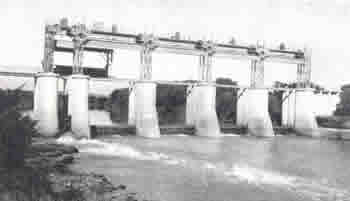
On 24 December 1926 an agreement was reached between the Minister of Railways and Harbours and ESCOM for the take over of the Colenso Undertaking. The date of the take-over was subsequently fixed for midnight on 15/16 January 1927, and the undertaking became known as the Natal Central Undertaking. The power station staff was taken over by ESCOM with the Undertaking. The total amount payable to the Railway Administration was £3,136 million but total costs to ESCOM, including water rights, licence, cost of raising charges and other sundries was £3,419 million. (ESCOM Annual Reports 1926:5,13, 1928:12)
At the time of the take over by ESCOM the undertaking consisted of:
A power station with a capacity of 60 MW
275 miles [445 km] of 88 000 V overhead transmission lines
A step-up sub-station at Colenso and 12 sub-stations situated at intermediate points for distributing electricity and converting it for traction purposes
Local distribution systems and other miscellaneous buildings and appurtenances.
(The transmission lines and rectification equipment which were exclusively used for traction purposes, were transferred back to the Railway Administration from April 1948).
The initial plant installed at the power station consisted of five 12 MW turbo alternators, which were designed to carry 20 MW for two minutes at a time. The steam raising plant consisted of eight boilers, each of which had a normal evaporation of 60 000 lbs. of steam per hour [7,6 kg/s] but were capable of working continuously at 25% overload if required. The Tugela River was used as the cooling water system. ESCOM Annual Report 1926:6; ESCOM Ten Years 1923-1933:55)
On 29 June 1927 the Permit granted to ESCOM by the Control Board on 26 June 1925 was substituted by a Licence “to acquire and carry on an Undertaking for the supply of electricity in the Central area of the Province of Natal, and for that purpose to ..operate, use and maintain” the power station and the other assets taken over. (ESCOM Annual Report 1926:10)
The Railway Administration appointed the British firm Merz and McLellan as consulting engineers for the Natal electrification project. Excavation work for the power station was commenced in September 1922 and by March 1923 the foundations were ready for the steelwork. (This was the month when ESCOM was established). By the end of November 1923 good progress had been made with the engine room steelwork and by the end of January 1924 the first chimney had been erected. During March 1924 installation of the generators and boilers was in progress and by the end of May 1924 the first four boilers were almost complete. By the end of August 1924 boiler 1 had been completed and boiler 2 was under steam pressure. By the end of September 1924 generator 1 had been run on test and generator 2 was almost complete. By the end of November 1924 drying out of boilers 7 and 8 was proceeding and generators 1 and 2 were being run for track work and equipment tests. By the end of 1924, the buildings were completed and generator 3 had been on test. (South African Railways and Harbours Magazine, – General Manager’s Bulletin, May 1923:416, Jan.1924:11, Mar.1924:213, Jun.1924:543, Jul.1924:682, Oct.1924:973, Nov.1924:1087, Jan.1925:14, Feb.1925:11)
During January 1925 generators 1, 2 and 3 were in service for track work and erection of generators 4 and 5 was proceeding. A temporary closing down of the power station was necessary from 7 to 20 February and 16 March to 14 April 1925, on account of silt having accumulated in the intake to the circulating water pumps. During May 1925 the power station was in continuous operation with the first four generators, and generator 5 was nearing completion. (At this stage HRH the Prince of Wales passed through the town of Colenso by steam train). At the end of June 1925 generator 5 was on test and 5 of the 8 boilers were in commission with two others available. (South African Railways and Harbours Magazine, – General Manager’s Bulletin, Mar.1925:194, Apr.1925:300, Jul.1925:655, Aug.1925:776, Sep.1925:862; South African Railways and Harbours Annual Report 1924/25)
Note: The original water intake was set back from the river bank, adjacent to the power station, and the earth between the pump house wall and the river was removed after the suction pipes and the screens had been erected. To alleviate the silt problem, a new intake was built in 1925/26, positioned further out into the main stream of the river, and the Railway Administration entered into contracts for the construction of a barrage across the Tugela River. This consisted of four gates each 40 feet [12 m] clear span and one of 10 feet [3 m], erected about 4 000 feet [1,2 km] downstream, for the purpose of regulating the flow past the intake. ESCOM later also installed rotary strainers between the screening plant and the circulating water pumps. (South African Railways and Harbours Magazine, May 1923:416/7, July 1926:943, May 1927:69 [photograph 1926]; ESCOM Ten Years 1923-1933:36; ESCOM Annual Report 1935:14; ESCOM Megawatt No.25/1972:19 [photograph showing the original water intake in 1924])
The traction load in the year 1927 represented over 96% of the total sales and the demand could fluctuate over a range of 20 MW within a few minutes. Prior to the acquisition of the Colenso Undertaking by ESCOM the Railways had been considering recommendations for extensions to the power station. In consultation with the Railways, ESCOM decided to extend the boiler house to accommodate four more boilers and to proceed at once with the installation of two additional boilers, similar to the existing boilers. This would provide relief due to the fluctuating load. This work was completed in 1928. (ESCOM Annual Reports 1926:9; 1927:10; 1928:1)
Electrification of the Pietermaritzburg to Cato Ridgerailway line was completed in 1931. By 1935 the traction load continued to pose a problem, with fluctuations from 10 to 45 MW within a few minutes. At times the power station would be “swamped” with load leading to momentary interruptions in supply. These fluctuations “called for exceptional vigilance” on the part of the boiler house staff. The Cato Ridge to Durban section (approximately 70 km and which included the doubling of many miles of track and ten tunnels in the hilly countryside) was officially opened on 1 December 1936. The Hon. O Pirow, K.C., M.P., Minister of Railways and Harbours and of Defence, performed the opening ceremony, arriving at 10:00 on the first electric train to enter Durban station. Dr van der Bijl, Chairman of ESCOM, and Mr TH Watermeyer, General Manager of the South African Railways and Harbours, were among the dignitaries who had also travelled on this special train from Rossburgh to Durban. They were met by the Mayor of Durban and a large crowd including a military band. Power was supplied from Colenso Power Station for the entire 186 miles [299 km] of track from Colenso to Durban. (ESCOM Ten Years 1923-1933:25; South African Railways and Harbours Magazine January 1937:9-13; ESCOM Annual Reports 1936:8-9, 1938:23)
By 1938 the electrified railway line extended also 135 miles [217 km] northwards to Volksrust and 142 miles [229 km] towards Bethlehem. Two boilers at Salt River Power Station in Cape Town, similar to the Colenso boilers, were replaced by larger boilers in 1936. These boilers were transferred to Colenso and were installed in 1938. This would provide additional relief due to the fluctuating traction load. Electrification of the old section of the Natal main line between Rossburgh and Hillcrest was started in 1938, but was later abandoned for the duration of World War II due to delays in delivery of equipment. It is interesting to note that South Africa had 1 217 miles of electrified track in 1938, and approximately half was in Natal. Electrified track in Great Britain was 857 miles. (ESCOM Annual Reports 1929:21, 1935:14, 1937:19, 1938:13&23, 1944:20)
Note: Congella Power Station was built at Durban with the primary objective of supplying the growing needs of the Durban Corporation. It was intended that the station would be extended immediately the Railway Administration decided to electrify the Durban-Pietermaritzburg line. The station was started up in July 1928 with two 12 MW sets rated for 20 MW momentary traction load, as were the Colenso sets. The station was extended in 1929/30, 1932, 1934 and in 1938, when installed plant capacity was 98 MW. But due to growth in load at Durban and later the non-delivery of two sets during the war, Congella was unable to supply traction load until the end of 1948. (ESCOM Annual Reports 1923:10&11, 1928:29, 1938:37, 1948:12)
Due to recirculation of the cooling water at Colenso causing excessively high temperatures at the circulating water intake during low river flow, an alternative discharge duct was constructed one mile upstream in the river during 1938. This would provide a much larger surface area for cooling especially during the dry season water level. (ESCOM Annual Report 1938:23)
As originally built, space had been provided for a sixth set in the engine room. A 25 MW generator was ordered in November 1939, but on account of delays due to World War II (1939 to 1945), it was not expected to be in operation before the end of 1941. This set went into commercial operation only in July 1943. The installed capacity of Colenso was then 85 MW and there were 12 boilers, including the two brought from Salt River. Due to growth in load of other consumers, the traction load at that stage represented about 80% of the total sales in the Undertaking. (ESCOM Annual Report 1944:17)
As further generation capacity would be required within the next two years, it was decided to order an additional 25 MW set and two boilers rated at 180 000 lb/h [22,7 kg/s], ready for service in June 1947. The engine room would have to be extended and another boiler house added. It was decided to make provision in the new buildings for two further sets and four boilers. There would be a new control room entirely separate from the original control room. The extension was virtually a new power station and the old and the new sections were referred to as Colenso Nos. 1 and 2. The steam conditions at the turbine inlets in these stations were almost the same, but the voltage of generation was 6,6 kV in the old station and 13,2 kV in the new station. (ESCOM Annual Reports 1944:17, 1945:17, 1050:10)
The increasing river water temperatures would necessitate erection of three cooling towers, two of which would be provided initially. Each would have a normal capacity of 1,2 million gallons per hour [1,5 kl/s] with an overload rating of about 2 million gallons per hour [2,5 kl/s]. The towers would be arranged for supplying the new extensions, and in an emergency, the existing station in order to overcome the difficulties due to choking of pipes experienced at times of flood. (ESCOM Annual Report 1944:17)
The civil works and the turbine house steelwork were well in hand by the end of 1945 and the delivery of the boilers and turbine was expected late in 1946. Some items of the new plant did arrive during 1946, but there were further delays in the manufacture of the overseas plant, which was then expected only by mid-1948. Before the generator (no.7) was commissioned, another 25 MW set (no.8) was ordered together with three boilers of 180 000 lb/h [22,7 kg/s] capacity. Generator no.7 was eventually commissioned in February 1949 and the two boilers in June and August 1949. The traction load at that stage represented approximately 70% of the sales in the Undertaking. (ESCOM Annual Reports 1945:17, 1946:21, 1949:6&20)
There were also delays with the next additions. Material for the three boilers started to arrive in March 1952. The costs of the extension estimated in 1948 at £0,981 million were revised in 1952 to £1,425 million. The generator (no.8) was commissioned in July 1953 and the first boiler (no.16) in June and the second (no.18) in November 1953. The “C” extension was completed the next year when the third boiler (no.15) was taken into service in April 1954. This brought the installed capacity of Colenso up to 135 MW. The traction load was then about 55% of the Undertaking sales. (ESCOM Annual Reports 1952:9, 1953:39, 1954:41)
By the end of 1956 a 30 MW generator had been ordered together with two boilers rated at 200 000 lb/h [25,2 kg/s]. This was the “D” extension and work was started during 1958 and the installation was completed during 1959. The station then reached its final installed capacity of 165 MW with nine generators and nineteen boilers. (ESCOM Annual Reports 1956:15, 1958:37, 1959:13)
A summary of the principal equipment installed is as follows: (chain grate stokers on all boilers)
|
Colenso 1 Boilers: Generators: |
270 lb/sq.in. [1,97 MPa (abs)] 730 °F [388 °C] B&W 8 – 60 000 lb/h [7,6 kg/s] B&W 2 – 80 000 lb/h [10,1 kg/s] B&W 2 – 80 000 lb/h [10,1 kg/s] Parsons 5 – 12 MW 6,6 kV BTH 1 – 25 MW 6,6 kV |
Commissioning Date 1924/1925 1928 1938 (Ex Salt River) 1924/1925 July 1943 |
|
Colenso 2 Boilers: Generators: |
290 lb/sq.in. [2,10 MPa (abs)] 740 °F [393 °C] B&W 2 – 180 000 lb/h [22,7 kg/s] B&W 3 – 180 000 lb/h [22,7 kg/s] B&W 2 – 200 000 lb/h [25,2 kg/s] 280 lb/sq.in. [2,03 MPa (abs)] 725 °F [385 °C] BTH 1 – 25 MW 13,2 kV BTH 1 – 25 MW 13,2 kV Parsons 1 – 30 MW 13,2 kV |
Commissioning Date Jan/Aug 1949 Jun/Nov 1953, Apr 1954 1959 Feb 1949 July 1953 1959 |
|
TOTAL |
19 Boilers 264,6 kg/s 9 Generators 165 MW |
Data source: ESCOM Ten Years 1923-1933: 55; ESCOM Twenty-five Years 1923-1948: 40; ESCOM Annual Report 1950: 90; ESCOM Annual Report 1983: 49
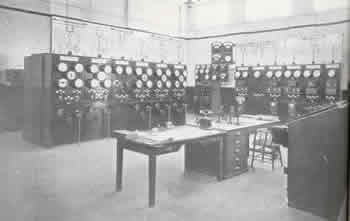
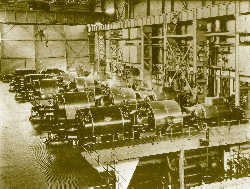
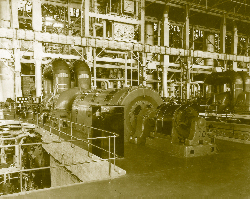
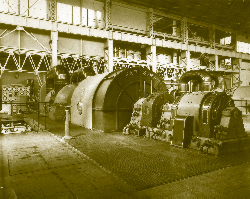
ELECTRICITY GENERATION
Net generation in 1927, the year in which Colenso was taken over by ESCOM, was 106,7 GWh. In 1939 an interconnection between Congella Power Station and the Booth Sub-station (on the railway route near Congella) made it possible for Congella and Colenso to render limited assistance to each other in case of emergency. This interconnection, via a 15 MVA 33/88 kV transformer, proved of great mutual advantage on many occasions. From 26 December 1948, Congella supplied the traction load between Durban and Cato Ridge (approximately 10 MW). In 1952 and in 1953, Colenso assisted Congella with peak loading via the distribution network, and from March 1954 a 132 kV interconnector between Colenso and Umgeni Power Station was in service. Generation at Umgeni commenced at the beginning of April 1954, and Congella, Umgeni and Colenso were operated in parallel. The Durban Undertaking then became the Natal Southern Undertaking. (ESCOM Annual Reports 1939:20, 1943:10, 1948:12, 1953:39, 1954:13, KM Nero:2003)
Annual net generation at Colenso increased steadily to 771,1 GWh in 1960, which was the maximum during the operating life of the station. From 1960 Colenso operated with Congella and Umgeni Power Stations of the Natal Southern Undertaking as pooled stations and generation at Colenso was eased. The first set at Ingagane Power Station was brought into service in 1963, and in 1964 the Natal Central and Natal Southern Undertakings were amalgamated to become the Natal Undertaking. Traction load then represented less than 20% of the total sales in the Natal Undertaking. For the ten years 1962 to 1971 annual net generation at Colenso averaged approximately 655 GWh. After the Natal system became linked up to the Eastern Transvaal (Mpumalanga) system via the 400 kV transmission grid in October 1971, net generation dropped sharply to 285,7 GWh in 1972 and 132,1 GWh in 1973. Annual net generation averaged approximately 220 GWh for the ten years 1975 to 1984, and in September 1985 the station was finally taken out of service. (ESCOM Annual Reports 1960:38, 1961:38, 1963:50, 1964:35, 1971:6, ESCOM Statistical Yearbook 1985:12&13)
The highest net maximum power produced (max demand sent out) was 160 MW and occurred in the year 1971. The link-up with the 400 kV transmission grid was planned to have taken place before the winter of that year, but on account of delays due to shortage of steel and cement, the Natal stations were required to operate at maximum output throughout the winter. The previous maximum had been 145 MW in 1959. (ESCOM Annual Report 1971:106)
Due to the steam pressure in use at Colenso being only 2,0 MPa (abs), the annual thermal efficiency exceeded 19% only five times throughout the operating life of the station. The highest thermal efficiency was 19,2% and was achieved in the year 1950. By comparison, Salt River 1 Power Station, which originally had the same boiler plant (two boilers were transferred to Colenso in 1936-38), achieved an efficiency of 21,7% in 1936 with its new boilers rated at 3,0 MPa (abs).

The table below gives operating statistics for the following years:
1928 The first full year after take over by ESCOM
1944 The year after generator 6 was commissioned
1950 The year after generator 7 was commissioned and also the year of highest thermal efficiency
1954 The year after generator 8 was commissioned
1960 The year after generator 9 was commissioned and also the year of highest generation
1971 The year of highest net maximum power (maximum demand)
1972 The year after the link-up with the 400 kV transmission network
1984 The last full year in service
| YEAR | Net Generation GWh | Net Max Power MW | Load Factor net basis % | Thermal Efficiency net basis % | Coal Consumed metric ton | Calorific Value of Coal MJ/kg | Cost of Coal R/metric ton | Net Water consumption litre/kWh |
| 1928 | 119,5 | 27,0 | 50,3 | 16,7 | 89 414 | 28,89 | 0,88 | Not available |
| 1944 | 352.7 | 66,0 | 60,9 | 18,4 | 241 119 | 28,56 | 1,14 | Not available |
| 1950 | 439,5 | 85,0 | 59,0 | 19,2 | 287 868 | 28,63 | 1,46 | Not available |
| 1954 | 519,5 | 109,7 | 54,1 | 19,1 | 347 134 | 28,17 | 2,15 | Not available |
| 1960 | 771,1 | 137,9 | 63,6 | 18.9 | 568 486 | 25,77 | 3,44 | 2,38* |
| 1971 | 560,2 | 160,0 | 39,9 | 17,9 | 433 463 | 26,05 | 4,51 | 4,98* |
| 1972 | 285,7 | 149,6 | 21,7 | 18,0 | 224 231 | 25,51 | 4,68 | 7,65* |
| 1984 | 163,0 | 77,0 | 26,6 | 18,7 | 120 453 | 26,17 | Not available | Not available |
* Calculated from Tugela river water usage
The coal burned at Colenso was at first “steam coal” (3 to 19 mm) and later “bituminous mixed smalls” (0 to 25 mm). During the first years of operation the calorific value was sometimes over 29 MJ/kg [12 500 Btu/lb] but there was a gradual decrease over the years to below 28 MJ/kg after 1954, below 27 MJ/kg after 1958 and below 26 MJ/kg after 1971. (ESCOM Ten Years 1923-1933:55; ESCOM Twenty-five Years 1923-1948:40 and ESCOM Annual Reports – Tables of power station operating statistics).
Coal was delivered by rail and there were several occasions when shortage of coal caused “grave anxiety”, with stocks barely sufficient for one day’s requirements. On one occasion in 1949 the complete shut down of the station due to shortage of coal was narrowly avoided. During that year “round coal” (above 35 mm) was sometimes supplied and required crushing before it could be used. (Note: Between 1946 and 1951 similar problems were experienced at Salt River and Table Bay Power Stations in Cape Town). (Escom Annual Reports 1937:19, 1949:20, 1951:22, 1952:39)
CLOSURE OF THE POWER STATION
During the second half of the 1960s, ESCOM began construction of a 400 kV transmission system that would link all Undertakings throughout the country. With increasing quantities of power being called for, the transmission of power at high voltage from large power stations situated at the coal-fields in the Eastern Transvaal (now known as Mpumalanga) was becoming a cheaper option than transporting coal to smaller power stations built at the main load centres. An amendment to the Electricity Act allowed ESCOM to establish the Central Generating Undertaking (the CGU) as from 1 January 1972, and group together the power stations of the various previously existing Undertakings. This would enable ESCOM to obtain the maximum benefit from pooling. The first 400 kV line from Camden Power Station in the Eastern Transvaal to Chivelston, near Ingagane Power Station in Natal, was completed in October 1971. Duplication of the 400 kV line was completed in September 1972. This enabled the older and less efficient power stations in Natal to reduce generation. Over 50% of the electricity fed into the Natal system was imported from the northern power stations during the last three months of 1972. Net generation at Colenso reduced from 560 GWh in 1971 to only 132 GWh in 1973 as a result of the 400 kV interconnection. (ESCOM Annual Reports 1966:11, 1970:7, 1971:6&106, 1972:5, 13&87
The original five generators were decommissioned in 1973, and the sixth in 1980, leaving the last three generators and six boilers in service with a station installed capacity of 80 MW. Due to a decrease in the national rate of growth for the demand of electricity, Eskom was experiencing a surplus of generation capacity in the second half of the 1980s and thus the older power stations were no longer required. Colenso, the longest serving station at that time, was finally taken out of service and decommissioned in September 1985. (ESCOM Annual Reports 1973:67, 1980:49; Escom Statistical Yearbook 1985:12&13
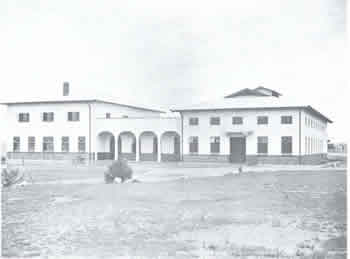
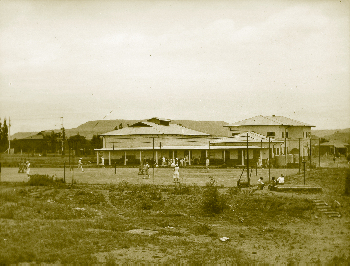
(ESCOM Annual Report 1928:16; ESCOM Megawatt No.25/1972:19-20, No.32/1974:35)
When the Colenso No. 2 station was built in 1944/45, new workshops and a stores building were constructed to replace the previous buildings, which were demolished to make way for the new turbine and boiler houses. These buildings, and an adjoining personnel block, including spacious mess rooms, a kitchen and change rooms with ample locker and ablution facilities, were modernly equipped to provide adequate accommodation for the maintenance and stores staff. Construction of twelve dwelling houses was commenced as part of the larger housing programme to provide for immediate needs and for future staff that would be required when the power station was extended. By 1948, sixteen houses had been built and occupied. Orders were placed for a further twenty, which were completed and occupied in 1949, and water-borne sewage was being installed to all houses. ESCOM continued to supply potable water in bulk to the Colenso Town Board, which earlier had assumed responsibility for water reticulation. Certain of the water mains, formerly the property of ESCOM, were transferred to the Board. As more houses were required, plots were purchased and another twelve houses built. These, and the sewage system, were completed in 1951. (ESCOM Annual Reports 1944:17, 1948:23, 1949:20, 1950:22, 1951:22)
The office accommodation at the power station was extended in 1952 and new first aid rooms provided. The mechanical workshops were moved to the old stores building, which was suitably enlarged. Change room accommodation at the power station was improved and additional accommodation provided. Further workshop additions were made in 1965. Twenty more houses were constructed and occupied in 1966 and a bulk supply of electricity was made available to the Borough of Colenso in October 1966, when the Council took over the reticulation of electricity within its area. From the take over of Colenso Power Station, Escom had undertaken to do so. (Escom Annual Reports 1952:39, 1965:34, 1966:37&38)
The village of Colenso was originally a wagon halt. The town was laid out in 1855 and was named after Bishop JW Colenso (1814-1883), first Anglican Bishop of Natal. The railway line reached Colenso in 1886. During the Anglo-Boer War there was heavy fighting in the area on account of the strategic bridge over the river. Lt. Roberts VC, son of Lord Roberts, was killed in the Battle of Colenso on 15 December 1899, and a monument was later erected to his memory. The power station was built on the actual battlefield. When construction of the power station began in 1922, it was a lifeless village consisting mainly of Indian and Arab stores. It was hoped that with the power station being built there, it might develop into a thriving industrial town. It was proclaimed a township in 1926 and a borough in 1958. The town had a population of 2 750 in 1969 and 3 620 in 1978. (South African Railways and Harbours Magazine, May 1922:394, May 1925:442; Pask 1926:93; Encyclopaedia of Southern Africa; Standard Encyclopaedia of Southern Africa; ESCOM Megawatt No.25/1972:18-20)
NOTE: Earl Roberts was the second British commander in chief (Dec.1899-Nov.1900) in the Anglo-Boer War. In a skirmish near Colenso, Sir Winston Churchill, then a war correspondent for The Morning Post of London, was taken prisoner by the Boers. (The New Encyclopaedia Britannica; ESCOM Megawatt No.25/1972:18)
In an article by FR Mitchell, who had been at the power station only six weeks before it was taken over from the Railways, he reminisced about the effect the construction of the power station had on Colenso. He remembered how the construction, which began in 1922, transformed Colenso into a boomtown. The Electric Hotel was built and many new shops were opened. The Tugela Hall was erected and this provided the first cinema in Colenso. The existing school had to be extended due to the increase in the number of children. (ESCOM Megawatt No.25/1972:18-20)
While the power station was still in the commissioning stage, heavy rainfall and the subsequent flooding of the Tugela River, resulted in a build up of silt at the power station intake works. This necessitated a temporary shut down of the power station in February 1925. The rains caused damage to the Onderbroekspruit Bridge between Colenso and Harts Hill. It collapsed as a train passed over on the night of 21 March 1925, resulting in the death, by drowning, of the engine driver, fireman and eight passengers. (South African Railways and Harbours Magazine, April 1925:300& 301, May 1925:518 [photographs]; ESCOM Megawatt No.27/1973:35 [with photograph])
Mr HP Alexander, who managed ESCOM’s operations in Natal for a considerable period of time, mentioned the experience of the night shift-engineer who looked out at the swollen river which was just below the top of the intake wall, and saw a dog apparently walking over the water. When the engineer went out to investigate he attempted to submerge his twelve foot measuring pole and found the water only two feet deep. Silt had been deposited in the inflow tank. This caused the shutdown of the power station for about a month. (ESCOM Megawatt No.27/1973:37-38)
On 2 June 1925, not long after the storm and the shutdown of the power station, the Prince of Wales (Prince Edward) passed through Colenso on his way to Durban, having stopped overnight on 1 June at Harrismith where he laid a wreath at the War Memorial. Nine years later, in 1934, Prince George (the King’s youngest son) also passed through Colenso on the White Train. (South African Railways and Harbours Magazine, “With The Prince Day by Day”, May 1925:392, 407-495, March 1934:251, April 1934:380 & 495; ESCOM Megawatt No.27/1973:35)
On 29 May 1926 over 80 members of the South African Institute of Electrical Engineers and South African Institution of Engineers, travelling overnight from Johannesburg by special train, made a visit to the Natal electrification works. Others who had made the trip from Durban joined this group. Among them were some of the most distinguished engineers in South Africa and overseas, including Mr Bernard Price, at that time Chief Engineer of the Victoria Falls and Transvaal Power Company. Their visit included the Colenso Power Station. Mr JA West, the Resident Engineer, conducted a tour of the station. (South African Railways and Harbours Magazine – “One Hundred Engineers Visit Electrification Work in Natal”, July 1926:958-964)
NOTE: Mr West came out from England to be the first Resident Engineer at Colenso, taking over from the Resident Construction Engineer, Mr Hayes. He was later appointed Local Manager of the Natal Central Undertaking and was followed by Mr HH Jagger as Resident Engineer. Mr Jagger later became Manager of the Cape Western Undertaking. (ESCOM Megawatt No.25/1972:19-20)
A policy of employing white labour for certain unskilled work previously performed by blacks, was introduced at Colenso Power Station during the economic depression of 1930/31. It was hoped that the men would qualify for promotion to more responsible work. With the assistance of the Labour Department, suitable men were located and about 40 were employed. Few discharges were necessary, but a large number of changes took place, mainly due to the men obtaining better employment elsewhere. The average duration of service was 8 months. They were accommodated at a nominal charge in the wood and iron quarters used by the construction workers, and a mess was organised providing a plain but nourishing diet. But as the general prosperity of the country improved, it became increasingly difficult to fill the vacancies that occurred as the men found employment elsewhere that paid more. (ESCOM Annual Reports 1930:15, 1931:22-24, 1935:15, 1936:21)
ESCOM made contributions towards providing secondary educational facilities at the Government primary school for the children of the employees. The employment of an additional teacher for the higher standards was subsidised. This continued until the number of children attending secondary school had reached the necessary minimum laid down by the Education Department to qualify for the provision of such facilities by the Department. (ESCOM Annual Report 1936:21)
The Club House at Colenso Power Station provided for recreation which could “be taken in the form of golf, football and tennis, and for indoor pastime…a billiard room, reading rooms and a dance and concert hall fitted with sound motion picture equipment”. Mr Alexander said his wife grew up in Colenso after moving there at the age of seven. According to Mrs Alexander, the community had to be completely self-sufficient. If people wanted a social life, they had to join clubs. Sporting activities were important to the employees of the Colenso Power Station. Tennis courts and bowling greens were constructed. Many of the events were organised as part of annual competitions with the Durban Undertaking. Some of the events included tennis, bowling, badminton and soccer. The Colenso Club was successful in outside sporting competitions e.g. winning the Prideau-Brown Shield at Bergville for bowls. A new event, which proved to be quite successful was a flower, vegetable and garden show held for the first time in 1960. Mrs Alexander recalls that people brought in animals that they had found and started a zoo in Colenso. The zoo was run by Eddie Pottinger and was closely supervised by the Parks Board. It provided a constant sense of interest and amusement. Many people spent their Sundays picnicking at the zoo. In 2003, the club still existed. (ESCOM Ten Years 1923-1933:29; ESCOM Megawatt Vol.2 No.1/1966:9, No.32/1974:32, No.33/1974:36)
When the power station was finally closed down, most employees were offered jobs elsewhere in ESCOM. According to Mrs Alexander, many employees chose to retire rather than face moving to a larger city or town, after living most of their lives in Colenso. The existence of the power station at Colenso had had an enormous effect on the town. Its construction transformed the village, whose greatest prior technological time of achievement had been the arrival of the railways in 1886. Colenso has never been the same since the closure of the power station. Economic activity has declined tremendously, and Colenso will perhaps never again see the kind of activity and energy experienced during the operating years of the power station.
This information on Colenso Power Station was produced by Riashnee Pather, a historical researcher from the University of Natal and Dick Fowler, a retired Eskom employee.
-
Conradie SR & Messerschmidt LJM: A Symphony of Power – The Eskom Story – Chris van Rensburg Publications (Pty) Ltd, Johannesburg, 2000
-
Dictionary of Business Biography, Vol.4, Edited by David J Jeremy, Butterworths, London 1985
-
Electricity Supply Commission: Annual Reports, 1923-1984
-
ESCOM: Golden Jubilee 1923-1973
-
ESCOM: Megawatt 1966-1981
-
ESCOM: Twenty-five Years – A record of the origin, progress and achievements of the Electricity Supply Commission, 1923-1948
-
Hopkins HC: Natal Railways – An Historical Sketch. In: South African Railways and Harbours Magazine, May 1922
-
Hoy, Sir William: Railway Electrification in South Africa. In: South African Railways and Harbours Magazine, May 1922
-
Jagger, The Hon JW: The Electrification of the South African Railways. In: South African Railways and Harbours Magazine, May 192
-
Kotze, Sir Robert: Electricity Supply in South Africa. In: South African Railways and Harbours Magazine, May 1922
-
Merz & McLellan: Electric Power Supply in the Union of South Africa, April 1920
-
Merz & McLellan: South African Railways – Report on the Introduction of Electric Traction, June 1919
-
Mills FW: – Electrification of the South African Railways. In: South African Railways and Harbours Magazine, 1919, 1922
-
Pask TP: The Past and Present in the South African Railways Electrical Department. In: South African Railways and Harbours Magazine, May 1922
-
Rosenthal, Eric: – Encyclopaedia of Southern Africa
-
South African Railways and Harbours Magazine, 1919 to 1927 & 1934
-
South African Who’s Who, Published by Ken Donaldson, 1912 & 1927-1928
-
Standard Encyclopaedia of Southern Africa
-
The New Encyclopaedia Britannica, 15th edition (Earl Roberts, Sir Winston Churchill)
-
Wilson D: – Natal Main Line Construction and Deviation. In: South African Railways and Harbours Magazine, 1919
-
General Manager of Railways and Harbours, Annual Reports 1912-1935, (Union Government Annexures presented to Parliament)
-
Lydall, F – The Electrification of the Pietermaritzburg-Glencoe Section of the South African Railways. In: The Journal of the Institution of Electrical Engineers (London), Vol. 66 1928, pages 1021 to 1064
-
Pask, TP – An Introduction to the Study of Electric Traction in Natal. In: The Transactions of the South African Institute of Electrical Engineers, Vol. XVII, Part 5, May 1926
-
Hoy, Sir William (born 1868 in Scotland) joined the Cape Government Railways in 1889 and became Assistant General Manager from 1 January 1909. After establishment of the Union of South Africa in 1910, he became General Manager of the South African Railways and Harbours. He was appointed a member of the Committee to consider the Merz Report of 1920.
-
Kotze, Sir Robert N (born 1870 in South Africa) became the Government Mining Engineer from 1908-1926 and was appointed by the Government as Chairman of the Committee to consider the Merz Report of 1920. The deliberations of this committee resulted in Parliament passing the Electricity Act of 1922 and the establishment of ESCOM in 1923. Sir Robert and Dr van der Bijl did the major part of the Committee’s work.
-
Merz, Dr Charles Hesterman (1874-1940), Consulting Engineer in Great Britain who took William McLellan (1874-1934) as a partner in 1909. In 1913 the firm employed a staff of 73 and were world leaders in the field of railway electrification and power station construction. Merz, and two of his children, were tragically killed during World War II by a direct hit on their Kensington home. (Dictionary of Business Biography).
-
Mills, Frederick William (born 1870 in England) came to Natal in 1895 for Messrs Woodhouse and Rawson, a firm of electrical engineers. He joined the Natal Government Railways in 1896 and introduced train lighting by electricity. He became the Chief Electrical Engineer for the SAR&H on 1 November 1911 and made initial reports and estimates on railway electrification. He conducted Merz over the proposed railway electrification routes in South Africa in 1919 and visited the major railway electrification schemes in America and Europe in 1920-1921.
-
Pask, TP (born 1873) became Superintendent (Electrical and Telegraphy) for the SAR&H in 1920 and Chief Electrical Engineer in 1925. He was appointed a member of the Committee to consider the Merz Report of 1920.
-
Lydall, F – An expert from the firm of Merz and McLellan, who came to South Africa in October 1917 to collect the necessary data for the report dated June 1919 “South African Railways – Report on the Introduction of Electric Traction”. Due to the change in conditions, he carried out a fresh investigation in 1921, and was Merz and McLellan’s chief representative in South Africa for the duration of the project in Natal.
